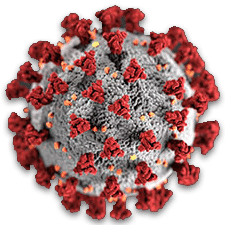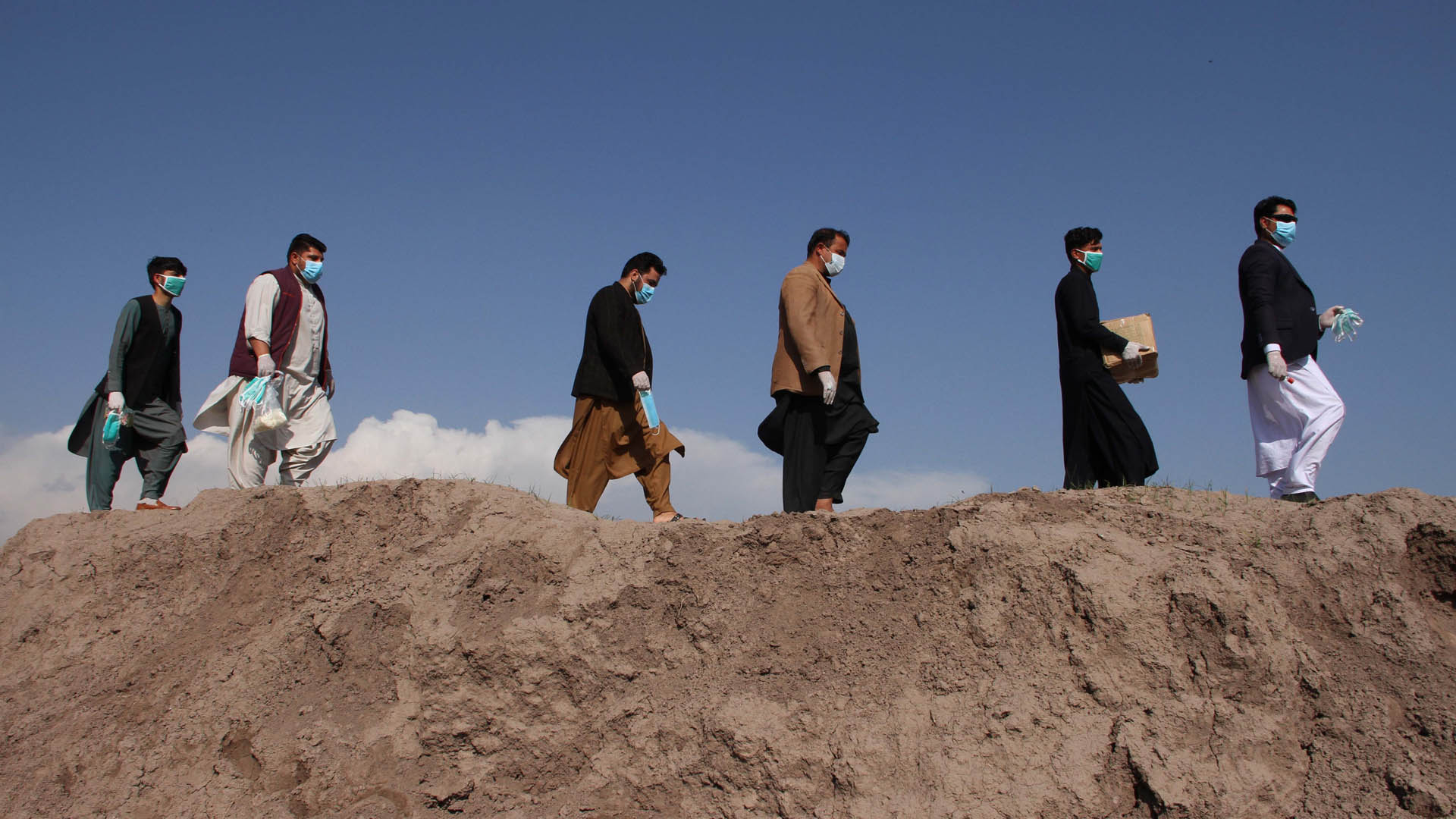Covid-19 cases cases surged across the country this week, spurring further restrictions on public life, new strains on an overtaxed health care system, and economic chaos.
More than 213,000 people have been infected in the U.S., and at least 4,513 have died — approximately one-third of them in New York City alone. On Tuesday, the federal government finally released its official projection of fatalities in the United States, where public health officials now predict 100,000 to 240,000 coronavirus-related deaths. (Those numbers should be understood as fluid estimates, not inevitable outcomes — and some experts have questioned the specific figures released by the White House.) Meanwhile, the Department of Labor announced on Thursday morning that an unprecedented 6.6 million Americans filed unemployment claims last week. That’s nearly an order of magnitude than more than the pre-coronavirus one-week record, set in October, 1982 — a mere 695,000 claims.
The speed of these changes has left analysts and world leaders grasping for analogies with past crises. The secretary-general of the United Nations, António Guterres, told reporters this week that the pandemic is the greatest challenge the world has faced since World War II. The jobs numbers in the U.S. provoked comparisons to the Great Depression of 1929 and the Great Recession of 2008. And as the death toll in the U.S. passed 3,000, many people pointed out that Covid-19 has now killed more people than the September 11th attacks. (As of Thursday evening, it was still less than the estimated number of Americans killed in Puerto Rico by Hurricane Maria).
Certain circumstances, though, have made this disaster feel both sudden and never ending. Infectious disease experts, after all, had been warning of a global pandemic for decades, and sharp-eyed observers were watching this particular virus emerge for more than three months. (The coronavirus first appeared in Undark’s Abstracts column on January 10). Public health experts have been clamoring for a more robust response for weeks, publishing what have proved prescient warnings of how serious the spread could get. Those admonitions spurred swift action in countries like South Korea, but other nations, including the U.S., were slow to find their footing, giving the virus time to seed itself, spread, and kill — with exponentially increasing speed. The experience can feel like watching 9/11 in slow motion.
The crisis has also highlighted how unevenly reliable information moves through American society. At times, the disjunct comes from deep-seated and tragic inequalities: for example, there is growing evidence that, as in past health crises in the U.S., some immigrant communities simply have not had access to reliable, understandable information, in their own languages, about Covid-19’s spread. (At least one new effort, the Covid-19 Health Literacy Project, is working to address that gap).
In other cases, the culprit seems to be willful ignorance: In a press conference on Wednesday, Georgia Governor Brian Kemp, who has resisted recommendations to impose social distancing for weeks, changed course, explaining that he had only just learned that people without symptoms can transmit the virus. This data point was known to experts, and had been widely reported in the news, for more than two months.
In this week’s Abstracts, as in previous weeks, we continue to offer a roundup of coronavirus themes that defined this week’s news, and that are likely to stay relevant in the days ahead.
 |
Got questions or thoughts to share on Covid-19? |
• American manufacturers are racing to set up production lines for medical equipment.
Hospitals around the country are facing ongoing shortages of the supplies, from face masks and gloves to ventilators and oxygen, which are needed to keep health care workers safe and many Covid-19 patients alive. With protective gear in the federal government’s Strategic National Stockpile nearly depleted and roughly half the ventilators in its stores distributed, U.S. manufacturers are trying to shift their production lines to fill in the gaps. In New England, several companies, including L.L. Bean and New Balance, have begun making masks, while automaker Ford has plans to produce up to 50,000 ventilators in the next 100 days at a plant in Ypsilanti, Michigan. For the most part, companies are participating voluntarily. President Trump has called on the Defense Production Act — a Cold War-era law — to compel General Motors to produce ventilators, but whether the company has begun doing so is unclear. And even with private sector help, public health officials note that well-known institutions are getting hold of newly made supplies, while smaller hospitals and nursing homes are going without.
• As its Covid-19 death toll surpasses 1,500, New York City works to find dignified places for the dead.
Faced with a sudden surge in bodies, New York City has begun to set up makeshift morgues that emergency planners call “body collection points.” In the crowded city, some BCPs are being built in locations that intersect with public life: The mobile morgue outside Wyckoff Heights Medical Center, for example, is visible from apartments across the street, according to reporting from TIME Magazine. That morgue is essentially a refrigerated truck with a ramp and wooden shelves. Another temporary morgue, currently the city’s largest BCP, is in a large tent outside of Bellevue Hospital in Manhattan. “The problem is funeral directors and cemeteries have decided to reduce staff because of Covid-19, and they are burying fewer people per day,” Mike Lanotte, the director of New York State’s Funeral Directors association, told CNN. “You are going to have a bottleneck of bodies if they are unable to bury in a timely manner.”
• Using the coronavirus as a proximate justification, several autocratic leaders — and at least one democracy — place worrying new restrictions on movement and speech.
The Philippines, Thailand, Cambodia. All have placed onerous new restrictions on speech related to Covid-19, ostensibly in an effort to curb misinformation and maintain public order. In Turkmentistan, the nation’s president and ostentatious strongman, Gurbanguly Berdymukhamedov, has vowed to fight the virus by insisting that it doesn’t exist in his country, threatening jail time for anyone wearing a protective mask in public, and banning use of the word “coronavirus” entirely, according to the Paris-based group Reporters Without Borders. Meanwhile, Hungary’s steady descent into autocracy under Prime Minister Viktor Orbán became a fait accompli this week, with Orbán’s ruling party effectively suspending elections and giving the prime minister the power to simply rule by decree — all, it was said, to address Covid-19. The country also now promises jail time for anyone spreading misinformation about the coronavirus pandemic. That last tack mirrored new regulations in South Arica — a stable democracy for nearly 30 years — promising prosecution of those who spread false information about Covid-19. In some autocratic nations, such regulations might be seen as par for the course. But in South Africa, some free-speech advocates worried that — even given the real damage that false information can do — such restrictions set a troubling precedent. “South Africa’s post-apartheid commitment not to criminalize information has been a beacon for press freedom across Africa,” said Angela Quintal, Africa coordinator for the Committee to Protect Journalists, in a prepared statement late last month. “But these new regulations have the potential to dim that light, opening up the possibility of abuse and limitations on vital information and facts.”
• Despite shortages and mounting controversy, demand for hydroxychloroquine remains high.
The anti-malarial drugs hydroxychloroquine (Plaquenil) and chloroquine (Aralen) — also used to treat auto-immune diseases such as lupus and arthritis — have been in dismayingly short supply since high-profile politicians, including President Trump, touted them last week as potential miracle cures in the battle against Covid-19. And Trump is not the only right-wing politician to embrace the high-hopes idea of a silver-bullet cure for the pandemic, dismissing the fact that the drugs have some significant toxic side effects. Those promoting the drugs seem also to be ignoring the very thin evidence that they may actually work as a coronavirus treatment. Some studies — like one in China looking at 62 patients in their 40s with relatively mild cases of infection — saw some improvement, especially in fever reduction. Other hospitals, such as a top ranked hospital in Paris — saw no improvement at all. For now, “we have more studies showing it doesn’t work than showing it does,” said one of the French researchers. Nevertheless, the U.S. Food and Drug Administration has authorized increased production of the drugs, in part in the hope that they may yet play a positive role, and in part to try to help out panicked lupus and arthritis sufferers, who have been struggling to renew prescriptions.
• In Washington, the curve appears to be flattening, even as Florida and Michigan emerge as potential epicenters.
While testing shortages have made it difficult to gauge the Covid-19 pandemic’s true rate of spread, there were indications this week that public health measures in some states may be flattening their curves. In Washington, the early epicenter of the U.S. outbreak and first state to mandate social distancing, models by state agencies and university researchers show the rate of new infections beginning to slow. They predict that Covid-19 deaths will peak in a week’s time. New hospitalizations also reportedly fell last week, although a glitch in the state’s data collection system could have skewed the numbers. In California, similar strict and early social distancing mandates have helped the state limit the surge in new cases, according to public health experts, but the state still lags in testing. Elsewhere, the news is less promising. In Florida, Governor Ron DeSantis waited until Wednesday to issue a stay-at-home order for his state, amid a surge of cases and steady criticism from health experts. Florida’s aging population, paucity of tests, and delayed response have many researchers and health care workers worried the state could soon face a crisis on par with the situation in New York City — if not worse. Meanwhile, officials in Michigan are concerned that Detroit and other communities with high rates of poverty and chronic illness — especially among people of color — could make their region vulnerable to a catastrophe.
There’s plenty of excellent reporting and analysis available.
Below is a list of some of the journalists, experts, and publications that Undark is following.
- Helen Branswell (@HelenBranswell), senior writer, infectious diseases, STAT
- Peter Sandman and Jody Lanard, risk communication experts
- Kai Kupferschmidt (@kakape), molecular biologist and science journalist, Science Magazine
- Trevor Bedford (@trvrb), computational biologist, Fred Hutchinson Cancer Research Center, Seattle
- Lawrence Gostin (@lawrencegostin), professor of global health law, Georgetown University
- Muge Cevik (@mugecevik), infectious disease researcher, University of St. Andrews
- Julia Belluz (@juliaoftoronto), health correspondent, Vox
- Ed Yong (@edyong209), science writer, The Atlantic
- Kaiser Health News, full coronavirus coverage
- ProPublica, full coronavirus coverage
- U.S. Centers for Disease Control and Prevention, latest coronavirus news
- World Health Organization, rolling coronavirus updates
- Global Covid-19 Case Tracker, Johns Hopkins Center for Systems Science and Engineering
- The Covid-19 Tracking Project
- The Syllabus, Coronavirus Reading Lists
- Virus Academics Twitter list
Undark will continue to provide weekly roundups of Covid-19 news each Friday for as long as the pandemic continues. You can find our own Covid-19 coverage here.
Deborah Blum, Lucas Haugen, Jane Roberts, Francesca Schembri, and Tom Zeller Jr. contributed to this roundup.












Comments are automatically closed one year after article publication. Archived comments are below.
The issue is simple: Disinformation from so many different sources and the truth of this Virus is at best Suspect. Yes, on the surface it is BAD. The truth of this is: It has become so Politically Controlled , the facts are so distorted and changing by any ” Official” at any level. Truth has no meaning. Just The Politician’s Truth. Can’t trust the WHO. Can’t trust the CDC Controllers as they are placed in position by a politician. In this case, Barrack Hussein Obama. Really, and trust they will, give the Whole truth, Nothing but the truth So help them in God’s Name or Allah’s name. Obama is a Islamist.